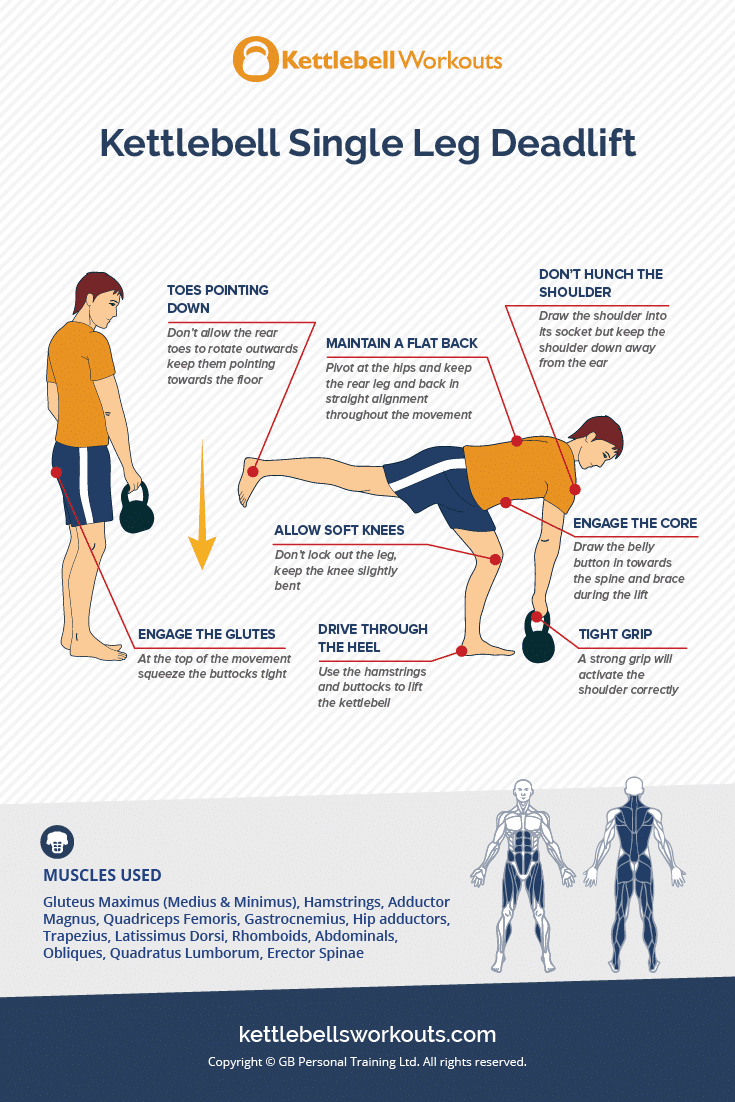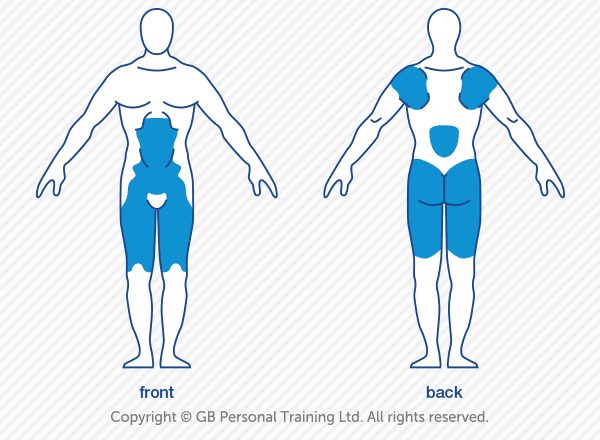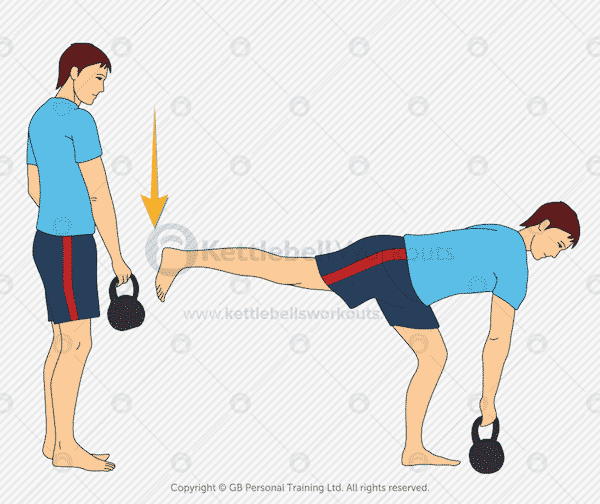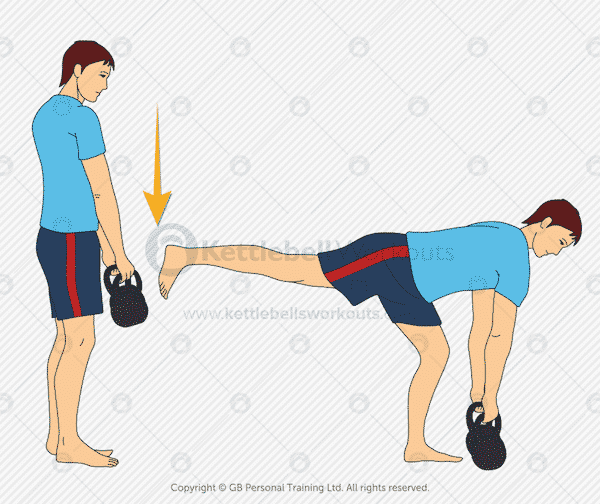
The Kettlebell single leg deadlift, single leg Romanian deadlift or one leg deadlift is a highly underused but extremely important hip-dominant exercise.
All beginners as well as seasoned professionals should be using the single leg kettlebell deadlift to create a stable foundation for their kettlebell training.
If you have not started using the one leg kettlebell deadlift then now is the time to embrace it and reap the rewards this fun unilateral exercise has to offer.
Kettlebell Single Leg Deadlift Benefits
The one legged deadlift is a challenging exercise in comparison to the traditional deadlift and requires good core strength as well as hip mobility, balance and coordination.
Here’s a quick list of the benefits of the one legged deadlift:
- Strengthens the core sling system that connects the shoulder to the opposite hip which is important for all sports and martial arts
- Develops good core coordination as the midsection resists ‘giving in’ to the kettlebell load as you lean forwards
- Promotes good synergy between the hip hinge movement, core muscles and shoulders
- Develops single leg balance, strength and stabilisation
- Improves mobility through the hips, legs and back for better movement skills, posture and range of movement
- Strengthens and activates over 600 muscles in the body, in particular, the posterior chain muscles
Other than not being very cardiovascular there are not many benefits that you can’t get from this kettlebell deadlift exercise.
Kettlebell Single Leg Deadlift Muscles Worked

As mentioned the single-leg deadlift works and activates over 600 muscles in the body.
In particular single leg Romanian deadlifts use these muscles:
- Hamstring Muscles
- Core Muscles, especially the Obliques, Erector Spinae
- Butt Muscles: Gluteus Maximus, Gluteus Medius, Gluteus Minimus
- Trapezius Muscles
- Forearm Muscles
The muscles that you are probably going to feel the most the next day following a workout using the single-leg deadlift are the back of your legs or hamstrings and buttock muscles.
Single Leg Deadlift Form

Very similar to the kettlebell single-handed deadlift and traditional deadlift, the 1 leg deadlift requires you to keep a very flat lower back while bending forwards from the hips.
The chest should be kept up and the focus placed down at about 3 feet in front of you.
Maintain a straight line along your back leg, back and through to your neck. Think of your back leg as an extension of your upper body.
Try to avoid opening up the hips too much by keeping the rear toes of the back left leg or right leg pointing downwards as opposed to outwards. A good cue is to corkscrew the rear left foot or right foot inwards.
The standing leg should have a slightly soft knee or soft bend and not be fully locked out.
As you bend forwards only go down as far as your hamstrings will allow and don’t reach or drop your shoulder.
When your low back starts to bend then you have reached your maximum ability.
For many people, they will not be able to touch the floor with the kettlebell and a small box or step can be used to gauge depth.
Ensure you maintain a good grip throughout the exercise as this helps to stabilise the shoulder muscles.
Watch a video of the Single Leg Deadlift form using a kettlebell:
How to Perform the One Leg Deadlift Exercise
You have 2 main options for how you can perform the kettlebell one leg deadlift:
- Start with the kettlebell on the floor, hinge down, pick up the bell with an overhand grip, return to the top starting position and then hinge back and return the bell to the floor, and then let go.
- Start with the kettlebell in your hand in the standing position, lower to the floor, touch the floor and then return to the top position
I would recommend that beginners start with the first option to improve their muscle activation between picking up and returning the kettlebell to the floor.
For those completely new to the single leg kb deadlift movement I recommend that you practice the exercise without a kettlebell first.
Watch this video to see how to perform the bodyweight single-leg deadlift variation:
Imbalances When Performing the Single Leg Kettlebell Deadlift
It is very common for one side of the single leg kettlebell RDL to be stronger than the other.
If one side is weaker then you must work to strengthen that side by performing the same or more repetitions on that side.
It is good practice to start every workout with your weaker side and not to perform more repetitions on your stronger side.
It is interesting to note that if you struggle with one side of the single leg kb deadlift how you will probably have the same weakness with that same side when performing the kettlebell turkish get up.
Learn more: Top 5 single leg exercises you need to know
Using Two Kettlebells for the Single-Leg Romanian Deadlift

As you get stronger at the 1 leg deadlift exercise you can either use heavier weight or hold two kettlebells rather than one.
Holding a kettlebell in each hand takes away the rotational aspect of the kettlebell exercise meaning that your cross-body core sling system does not have to work as hard.
However, the addition of the extra kettlebell will mean a greater balanced load through the back of your legs or hamstrings, buttocks and back muscles.
So just be aware that balancing out the movement with two kettlebells takes away the rotational element that is so important for sports.
Discover more: Top 5 kettlebell doubles exercises
Workouts for the Single Leg Kettlebell Deadlift
The kettlebell one legged deadlift is a low-repetition exercise that should be performed slowly and deliberately.
Here are 3 one leg deadlift workouts that you can use to practice the kettlebell exercise:
Workout 1
- Single Leg Dead lift – 5 reps Left
- Single Leg Dead lift – 5 reps Right
- Repeat 3 times
Workout 2
- Single Arm Deadlift – 10 reps each side
- Halo – 5 reps each direction
- Single Leg Romanian Deadlift – 5 reps each side
- Slingshot – 10 reps each direction
- Repeat 3 times
Workout 3
- Single Leg Deadlift – 1 reps Left
- Single Leg Deadlift – 1 reps Right
- Single Leg Deadlift – 2 reps Left
- Single Leg Deadlift – 2 reps Right
- Continue adding 1 rep and see how high you can get without losing proper form and technique
Discover more: 12 kettlebell workout formats to better achieve your goals
Conclusion to the Single Leg Deadlift
The single-leg kettlebell deadlift or single leg Romanian deadlift is a very important kettlebell exercise that everybody should be using in their training.
Not only does this important kettlebell exercise activate most muscles in the body but it also improves balance, coordination, and increases mobility.
Beginners should start by mastering the body weight version first before moving on to single-leg deadlift variations using a kettlebell. You can also use a resistance band or another type of free weight to add progressive overload to the movement.
You can perform the single leg deadlift with either one kettlebell or two but using two kettlebells removes the rotational aspect which is so important for sports.
I’ve listed 3 single leg deadlift kettlebell workouts for you to use to practice this great exercise just perform them slowly and deliberately.
Best of luck and enjoy this excellent kettlebell exercise.
Have you practiced the single leg deadlift using a kettlebell? Let me know more below:

The single leg deadlift strengthens the posterior chain muscles namely the glutes, hamstrings, lower back and core muscles. Your balance and movement skills will also be improved with this exercise.
You should hold the kettlebell or weight with the opposite hand to the leg you are standing on. Using opposite arms and legs like this activates the core sling system of muscles that attaches the hip to the opposite shoulder.
Practice. Begin with the body weight version to improve your balance and develop your stabiliser muscles before using light weights and then heavier weights. You can always reach towards a wall to help with your balance.



Leave a Reply